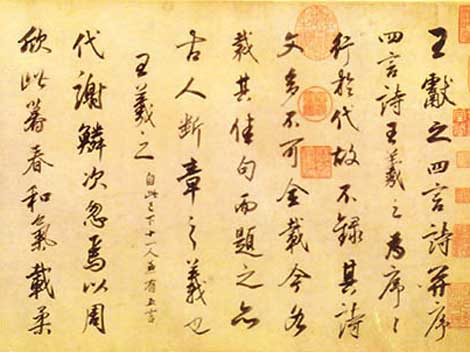Posted 2017/7/31

The Semi-cursive Script (also called "Running Script") is a calligraphy style with free movements, between the Regular Script and the Cursive Script. It was created in the late Eastern Han Dynasty to make up for the slow-speed writing of the Regular Script and the difficulty in reading the Cursive Script.
The most striking features of the Semi-cursive Script are stroke connection and omission, the inclusion of few or no cursive characters and the retaining of easily-readable structures of the Regular Script. Thus, the Semi-cursive Script is a practical style that can be quickly written and read with ease. The Semi-cursive Script is romantic and aesthetic and characterized by smoothness with no scribbles and regularity with no restriction.
The Semi-cursive Script matured in the Wei and Jin Dynasties. During the Eastern Jin Dynasty, the calligraphy style was best represented by the father-son calligrapher duo - Wang Xizhi and Wang Xianzhi. The most well known work in the Semi-cursive Script was the Lanting Xu (literally "Preface to the Poems Composed at the Orchid Pavilion"), which was honored as "the No.1 Semi-cursive Script work on the Planet". In the mid-Tang Dynasty, the great calligraphy master Yan Zhenqing brought calligraphy to a new realm and the Jizhi Gao (or "Lamentation for Nephew") he wrote was ranked as "the No.2 Semi-cursive Script work on the Planet".
The "Four Masters" of the Song Dynasty, i.e. Su Dongpo, Huang Tingjian, Mi Fu and Cai Xiang, were all influenced by Yan Zhenqing's Semi-cursive style. Between the late Ming and Qing Dynasty, the Semi-cursive Script enjoyed unprecedented booming development. But in the late Qing Dynasty, it gradually suffered declining. From the Republic of China to present, the main stream Semi-cursive Script has been focused on its interest and charm. Calligraphers like Kang Youwei, Qi Baishi, Sha Menghai and Shen Yinmo made contributions to the inheritance and continuing development of the traditional Semi-cursive Script.